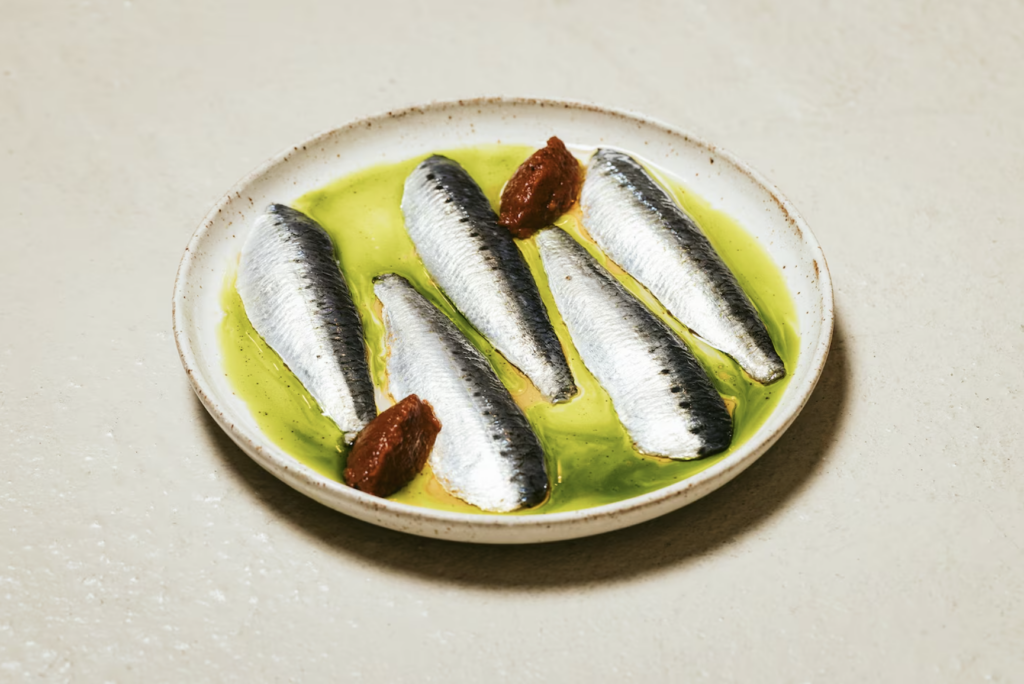A great-value dining destination, the Portuguese capital has a host of new restaurants and, as of last year, its own Michelin Guide.

Read the article online at nationalgeographic.com
The story of Lisbon’s culinary evolution over the past decade is one of homecomings. Portuguese chefs, having sought their fortunes in the great kitchens of Europe, were drawn home by saudade, that uniquely Portuguese concept of longing. And together with other homegrown and overseas talent, they’ve fuelled a gastronomic sea change in Lisbon, insisting on a lightness and daring that defies the conservative culinary leanings of the past century.
Today, Lisbon’s restaurant scene is as as cosmopolitan as you’ll find anywhere in Europe. With brasserie Santa Joana, molecular master Nuno Mendes has returned to his home city to offer a modern twist on Portuguese flavours — rich morsels such as grilled chicken hearts with pica pau sauce; and ocean-fresh dishes, from tuna belly to juicy red shrimps. And at Ofício, Hugo Candeias presents a modern take on a working-class tasca, the traditional rustic tavern at the heart of Portuguese gastronomy.
These restaurants, among numerous recent openings, decorate the compact, walkable historic centre and orbiting neighbourhoods, and are united by their pride in Portuguese ingredients. And in comparison to restaurants in many other European cities, they’re great value — even at the higher end. This hasn’t gone unnoticed by Michelin, which finally granted Portugal its own Guide in 2024, after years of sharing with Spain.
Several spots stand out among the Michelin cohort. Among them, Arkhe sees chef João Ricardo Alves draw on a formidable network of local suppliers, while plant-based gastronomy steps into the spotlight at Encanto, where José Avillez now holds Lisbon’s first Green Star for sustainably sourced dishes such as black truffle rice with lemon-marinated purslane. Elsewhere, Lisbon’s elite chefs take to the stage in theatrical show kitchens, including Marlene, where reinterpreted Portuguese classics, like truffle-stuffed partridge, offer a masterclass in culinary storytelling, making chef Marlene Vieira the first Portuguese woman in over 30 years to be recognised by Michelin.
Yet, even as it reaches for the stars, Lisbon’s food scene retains its humility, grounded in a strong national identification with the fisherfolk of its rugged Atlantic coastline and the farmers of its rolling hinterland. You’re never far from a tasca, such as A Provinciana, serving grilled sardines and meaty pratos do dia (dishes of the day), and As Bifanas do Afonso, specialising in hearty pork sandwiches. Ideally, these meals are followed by espresso laced with a shot of ginjinha (cherry liqueur) from the bars north of Rossio Square. With wallet-friendly odes to Portugal’s seafood and sun-sweetened wines woven into Lisbon’s fabric, it’s easy to see what drew Lisbon’s chefs home.
Alfama, Graçia and Mouraria
These medieval districts are the Lisbon of postcards. Vintage trams rattle past churches, washing hangs from Juliet balconies and every bend reveals a simple taverna. Start the day with something sweet at Casa São Miguel, a tea shop serving Portuguese treats from across the provinces. Pasteis de nata, Lisbon’s legendary custard tarts, are freshly made on site, but there are also rarer treats: carob balls from the Algarve and orange pie from Alentejo. Get your caffeine fix here, or wander uphill to Miradouro da Senhora do Monte, where a specialist coffee cart awaits most days.
If it’s a Saturday or Tuesday, Feira da Ladra flea market sets up beside São Vicente de Fora. Both this monastery and the nearby National Pantheon offer spectacular rooftop vistas but the area’s crowning glory is the 11th-century Moorish citadel, Castelo de São Jorge.
The working-class roots of Mouraria, the Moorish Quarter, inform the area’s cutting-edge tascas. Thanks to their well-priced small plates (modern takes on staples like pork belly and octopus), O Velho Eurico and Tasca Baldracca have a cult following. There’s only one place for dessert: Gelato Therapy. With branches opposite Miradouro do Graça and Lisbon Cathedral, it serves ice cream with kooky flavour combinations like stracciatella and sage.
Spend the afternoon browsing upmarket shops such as Chi Coração, which showcases Portugal’s textile heritage, or enjoy hilltop views from scenic Tram 28E. Then dinner awaits in Mouraria at Ciclo, with innovative sharing dishes like tempura onions and grapefruit seasoned with tosazu (a Japanese condiment); or in Alfama, where Lisbon’s mournful fado folk music can be enjoyed over a hearty glazed ribs or baked cod at Mesa de Frades, set in a former chapel decorated with azulejo tiles.
Santos, São Bento and Principe Real
Just west of the historic centre, this arc of desirable neighbourhoods cradles some of Lisbon’s most fashionable shops and restaurants. Breakfast on wasabi eggs benedict on the leafy patio of Marquise. And if it’s a Saturday, head over to the organic farmers’ market at Parque Príncipe Real, which sells local honey, cakes and orange juice. Across the street, don’t miss EmbaiXada, a 20th-century neo-Arab palace turned indie emporium showcasing the work of national and local designers.
The light interiors and pretty setting on the edge of Praça das Flores are the cherry on top of a playful sharing menu at Magnolia Bistrot & Winebar, whose highlights include a pork-filled brioche with comté and pineapple chutney. Alternatively, By Milocas, set within the Centro Cultural de Cabo Verde, celebrates the island cuisine of Cape Verde — a former Portuguese colony — with dishes like cachupa (a stew of pork, corn, beans and cassava), followed by syrupy crème caramel-like milk pudim.
Browse the antiques shops on Rua São Bento, pausing for gelato at Nannarella, or head south to the independent clothing and concept shops on Rua do Poço dos Negros; get loose-leaf tea and insights into Portugal’s role in bringing infusions to Europe at Companhia Portugueza do Chá.
An introduction to fado music awaits at Foundation Amália Rodrigues, the house-museum of Portugal’s greatest folk singer, with concerts in the garden on certain days. Time for a pick-me-up? Duck through the velvet curtains at tiny, speakeasy-style The Midnight Espresso, a cafe offering cocktails and spectacular deserts. Don’t miss the rooibos pecan pie.
Book ahead for a table at Tricky’s, where the vibe is fun but the food — such as kohlrabi pickle taco with ’nduja and tuna marinated in citrus kombucha — is to be taken seriously. And then end the night at Holy Wine, a tiny bar serving organic and biodynamic wines, where patrons spill out onto the street in the evenings.
Spotlight on seafood
The Portuguese are among Europe’s largest consumers of fish. Sardines and bacalhau (salt cod) are staples of the nation’s diet, the latter desalinated and then whipped into croquettes or bacalhau à brás, an unctuous bake with potatoes, eggs and olives.
There’s an ocean of seafood to explore in Lisbon, but a great place to start is at Último Porto, a casual grill hidden away in a former boathouse in the western docks. The quest to get there is rewarded by rustic seafood dishes like grilled cuttlefish in ink, where the freshness of the produce speaks for itself. Innovating in the seafood sphere is A Taberna do Mar, a quirky joint in Graça where a 10-course, Japanese-infused seafood tasting menu will set you back just €35 (£29).
Meanwhile, across the Tagus, reached by passenger ferry, Ponto Final is a waterfront taberna that serves up picturesque views of Lisbon along with memorable piri-piri prawns and a rich monkfish stew. Its popularity means it’s advisable to book months in advance or arrive an hour before opening.
Three fine-dining restaurants to try in Lisbon
2Monkeys
The team at 2Monkeys cook nightly for just 14 guests, constructing each dish in front of diners. Guilherme Spalk is scintillating in action, but the true drama lies on the plate. The audacious 12-course tasting menu, co-curated by Portugal’s most decorated chef, Vítor Matos, is rich with caviar and fine meats.
Arkhe
This vegetarian venue with just 18 covers was awarded a Michelin star this year. Chef João Ricardo Alves and co-owner/sommelier Alejandro Chávarro offer a seven-course tasting menu notable for its delicate sauces and French and Brazilian references. Try shiitake terrine with cashew cream and glazed asparagus.
Ciclo
Oysters with kiwano, and cockles and wild boar ’nduja are among the fresh flavours at this 2024 opening in the Moorish Quarter. Chef José Neves and host Claudia Silva are behind Ciclo’s zero-waste alchemy, transmuting peels, skins and tops into pickles and powders, on display in pots.
Three contemporary tascas to try in Lisbon
Ofício
Decadently playful sharing dishes are served with aplomb at this funky, informal address in the chic Chiado district. Awarded a Michelin Bib Gourmand just a year after its 2021 opening, chef Hugo Candeias’s self-described ‘atypical tasca’ is a local sensation. Expect foamy seaweed spaghetti enriched with quail yolks, tender scallops swimming in dashi and the creamiest Basque cheesecake.
Canalha
At this refined neighbourhood bistro-style restaurant, upriver in the Belém district chef João Rodrigues crafts a seasonal, ingredient-led menu featuring the likes of open prawn omelette and squid with sheep’s butter. Awarded a Michelin Bib Gourmand in 2024, this is a soulful homage to Portugal’s culinary heritage.
Tasca Pete
Seating just 18, this paired-back spot combines the vibe of a neighbourhood tasca with a modern small-plates restaurant and a focus on local, seasonal produce. Order a glass of natural wine and create a feast from the daily chalkboard menu of dishes such as blueberry focaccia and grilled octopus with charred corn puree and smoky chorizo.
Published in Issue 28 (summer 2025) of Food by National Geographic Traveller (UK).

